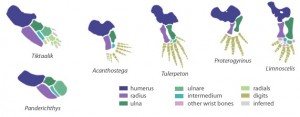Feathered dinosaurs might not still be the new boys in town in the fossil world, but there’s still a tonne of cool research being done on them. One of the main fields is trying to figure out if different species were capable of powered flight, like in most modern birds. The recent finding of Aurornis xui appears to have confined the ability to fly just to a single feathered lineage, the one leading to modern birds, but how do we figure out whether they could fly or not?

Reconstruction of Aurornis xui. Credit: Masato Hattori (source)

